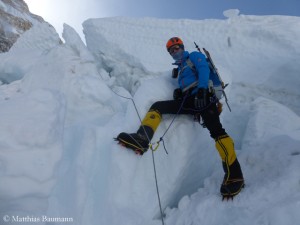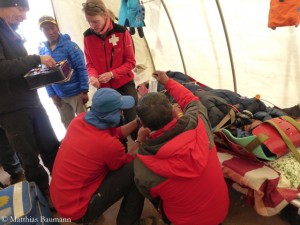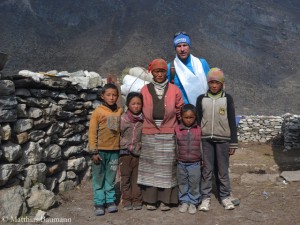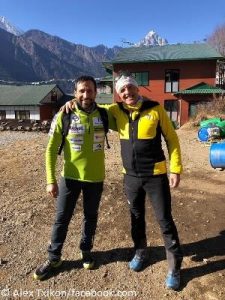German doctor wants to help Sherpa families in the long term
18 April has changed many things: on Mount Everest, in the lives of the families of the 16 avalanche victims – and also for Matthias Baumann. The 42-year-old trauma surgeon from the German town of Esslingen was the expedition doctor in the team of the Argentine twin brothers Damian and Willie (Guillermo) Benegas and actually wanted to climb Everest in his second attempt, on the Nepalese south side. In 2011, his first attempt on the Tibetan north side had failed at 8600 meters: When he wanted to change his oxygen bottle at the Second Step, the key point of the normal route, Matthias realized that his Sherpa had packed an empty instead of a full bottle.
Three years later, this spring, Baumann climbed through the Khumbu Icefall, on the day before the avalanche. “I knew that avalanches had been coming down from the West Shoulder of Everest for four or five years. Up there, the seracs are threatening”, Matthias told me. Even if the fun at climbing gained the upper hand, the respect remained. “I was always looking up to the seracs.” On the following day, the Khumbu Icefall became a death trap for 16 Nepalese climbers. With other physicians, the German doctor took care of the injured climbers who were brought down to the base camp. After the end of the expedition Matthias visited almost all the families of the Nepalese who had lost their lives – and launched a fundraiser for them.
“Matthias, at the time of the disaster you were at base camp. How did you experience the avalanche?
I was lying in my tent in the morning and was already awake. Suddenly there was this incredibly loud noise. I looked out of the tent and saw the snow dust that was falling over the whole Khumbu Icefall. I stood up quickly. There was an eerie silence in the base camp. I woke our expedition leader (Damian Benegas) up and said to him: ‘A large avalanche has come down. At that time many climbers were on the mountain. Something must have happened!’’ He got up at once. We agreed that I would stay in base camp to wait for injured climbers. Then he went up to the accident site.
Did the rescue operation work well?
Considering that it was not organized, it worked fine. People with experience in rescue, just like Damian Benegas or Michael Horst of “Alpine Ascents International” climbed up. The Sherpas who were already above returned and came down to the scene of the accident. They led the slightly injured down through the Khumbu Icefall. I’ve rounded up the doctors in base camp, it was an international team. Two doctors are stationed permanently on site, in the tent of the “Himalayan Rescue Association”.
As a doctor you have provided first aid. Did you onlyyour work as a physician or have you been charged emotionally too?
It has really shocked me. If such a disaster happens just where you are doing sport or climbing, it is not as easy as in the clinic to draw a bold line between these things. But of course, in the first place you are working. We took care of the patients quite well although we doctors did not know each other.
After the end of the expedition you have visited many families of Sherpas who lost their lives in the avalanche. What motivated you?
I trekked down from base camp by myself, because I wanted to process my experiences. I thought maybe I could visit a family. But before I reached the first family I thought: No, you have to visit all of them! It was just a spontaneous idea. I had never started a fund-raiser before. It was very sad, very emotional, but also a good feeling that I could help. I’ve been to all the families as the first who visited them.
How many families did you visit?
14 of the 16 families. I could not visit two families because they live in the Solu district and thus too far away. I didn’t have enough time to meet them too.
The members of the families were surely still traumatized.
Yes, they were heavily traumatized. They had just burned their dead father or husband. In most homes, the monks were still present and were doing pujas (buddhist ceremonies). In the most remote houses, there were only four, five monks, in Kathmandu 150. First it seemed to me that the women were very strong, they did not show much emotion. But in the end, when I gave a small donation to them and said goodbye, most of them were crying.
How did they respond to you as a western climber who wanted to express his compassion?
I felt no aggression and no reproach. Most were very grateful that someone came along and showed that he was thinking of them. They are all living in very remote areas. I felt that they were a bit disappointed that until then no one of these many, many mountaineers and expedition leaders had looked after them.
The families have not only lost a loved one but also their breadwinner. What does that mean for them? What happens to them next?
It is a very difficult road. In Sherpa families, the man is responsible for the finances, the women are at home and look after the children. For a woman in Nepal who has already children it is difficult or even almost impossible to find another man. The relatives and neighbours must support them. In a family I visited, the woman has some yaks and therefore she has a small income. But that is not comparable with the income of an Everest Sherpa, who earns 5,000 to 6,000 U.S. $ per season.
Many Sherpa families have many children. Had the children that you met already realized what had happened?
Of course this depends on the age. In Kathmandu, I met a daughter of an avalanche victim who was already 19 years old. She has already fully perceived the tragedy and feels the responsibility to care for her mother and grandparents. I visited another family with a baby of one month. The father had seen his child only once. And a family that is living north of Thame (a small village in the Khumbu region) near then Nangpa La (pass between Nepal and Tibet) had children of between four and twelve years. The twelve-year-old daughter picked us up on our way from Namche Bazaar (village and trading centre of the Khumbu) and led us to her home. During these four hours of walking I had the impression that she had not yet realized what the disaster meant for her family.
You’ve launched a fund-raiser for the families of the avalanche victims. Have your visits made you say: I can not simply return to my everyday life, I need to do something?
Yes, that was my motivation. Initially I visited the families only to give them first donations. I had not planned the larger project at this time. But the more families I visited, the greater became my wish to deepen the project to help them in the long-term.
Do you think that the Nepalese government’s help is not sufficient?
First it looked as if the officials would only give U.S. $ 400 per family. There were protests. I think the accident has caused a stir worldwide so that the Nepalese government is forced to do more. Above all, I hope that it will do more to support the children.
How do you ensure in your project that the money will actually reach the families?
I do know Pemba Sherpa for 20 years now, he is working for “Asian Trekking” and is one of those in the company who are responsible for the Khumbu region. We know each other since we attended an international mountain guide course in Chamonix. We stayed in touch and I visited him many times. I can trust him completely. But in addition, the families should confirm to me how much money they got and who brought it.
There have been discussions whether it was a good idea to finish the season on Everest. How do you think it about this, as someone who was on site when the tragedy happened and who did visit the victims’ families?
I think it was right to end the season. There was too much concern in base camp. Of course, 500 climbers have 500 dreams. But these dreams are not comparable with what has happened to the families. You have to postpone your personal dreams. I think it would not have turned out all right if climbing had continued , with Sherpas, who actually did not want to climb. There were some who wanted to continue but the majority was inhomogeneous. You have to work together to fix ropes. Actually, too much had happened.
There were also reports about pressure that was exerted by a small group of Sherpas. Did you notice that?
Yes, I did. I have spoken to many Sherpas. Within the expedition groups, there were divergent opinions between the Sherpas. There were many who wanted to continue. Other Sherpas have threatened to break their legs if they would enter the Khumbu Icefall again.
Are you going to return to Everest once more? And if so, will you do it on the Nepalese side?
Of course the dream lives on. If I have the time and financial opportunity, I’ll try it again someday. To me, the north side seemed objectively much safer. The south side was interesting because the route was a new experience for me. If I should ever get the chance again, I tend to go once more via to the north side.”
P. S. For those who want to support Matthias’ fund-raiser with donations, here are the bank details: Himalayan Project e.V., Kreissparkasse Biberach, IBAN: DE45 6545 0070 0007 0581 89, BIC: SBCRDE66, description: “Sherpa avalanche victims”. Thank you!












